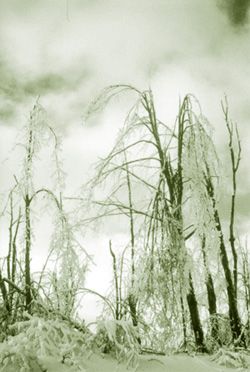
Freezing rain and forests: Minimizing
damage
The ice storm that hit southern Quebec in January
1998 caused substantial damage to forests. Researchers at the Laurentian
Forestry Centre of the Canadian Forest Service have studied trees
at 59 study sites1 in the five years that followed the
ice storm.
They have determined which factors favour the
restoration of stands and have proposed silvicultural initiatives
that can reduce the impact of freezing rain on woodlands.
Many stands and sites located in areas that received
more than 40 mm of freezing rain have not yet recovered from damage
caused by the 1998 ice storm (see box). Trees that were healthiest
before the ice storm or trees that suffered the least damage during
the storm have recovered more quickly. Initiatives taken before
the storm, such as thinnings carried out by sugarbush owners, helped
revive tree vigour. Some species also proved to be more resilient
than others2, including red oak, red spruce, white spruce,
sugar maple and American beech. However, balsam fir, cherry trees
and red maple are very susceptible to freezing rain.
Applying the following recommendations to woodland
management will help reduce the impact of future ice storms:
- promote tree vigour through frequent low-intensity
thinnings (3–5% of basal area at a time);
- ensure the health of stands by regularly removing
trees with many trunk defects or trees that are declining or dead;
- favour species diversity;
- depending on the type of stand, favour resilient
species.
1998 ice storm
Ice storms are probably the
only cause of large-scale mortality of deciduous trees in
southern Quebec. In January 1998, precipitation fell for five
days and totalled 120 mm in some areas. Experts estimate that
trees become susceptible to major damage as soon as freezing
rain accumulation exceeds 25 mm.
|

Severely damaged maple stand after the January
1998 ice storm (January 20, 1998, Weedon-Centre, Quebec).
Photo: J.-P. Bérubé |
For further information, please
contact:
Pierre DesRochers
Natural Resources Canada, Canadian Forest Service
Laurentian Forestry Centre
1055 du P.E.P.S., P.O. Box 3800, Sainte-Foy, Quebec G1V 4C7
Phone: (418) 648-3922 • Fax: (418) 648-5849
E-mail:
|
1 Sites of the North American Maple Decline
Project (NAMP) network and the Acid Rain National Early Warning
System (ARNEWS). At the time of the ice storm, data on the condition
of NAMP forests had been collected for at least 10 years, and ARNEWS
data for 15 years. See issue Number 7 of Branching out.
2 Resilience: ability to recover from disturbances.
© Her Majesty the Queen in Right of Canada 2003
Catalogue Number Fo29-54/8-2003E
ISBN 0-662-35321-8
ISSN 1705-5784
|